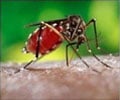A new study has identified one of the tricks malaria uses to hide from immune proteins - a finding that may help in future drug development.
A new study has identified one of the tricks malaria uses to hide from immune proteins - a finding that may help in future drug development.
Malaria is one of the world's biggest killers, killing over a million people every year, mainly children and pregnant women in Africa and south east Asia.It is caused by the malaria parasite (plasmodia), which is injected into the bloodstream from the salivary glands of infected mosquitoes.
Once inside their human hosts the parasites first set up shop in liver cells, then move into red blood cells (RBCs) to replicate and wait for the next mosquito to help continue the cycle.
After plasmodia infect a blood cell, they send out clusters of sticky proteins to the cell surface, enabling them to attach to blood vessels and escape destruction by the host's spleen while they replicate.
This tactic can be especially problematic during pregnancy as malaria-infected RBCs congregate in the vessel-rich placenta (the source of food and oxygen for the growing fetus), creating health problems such as anemia, low birth-weight, fever and more.
But targeting these sticky proteins with drugs is difficult, as plasmodia contain many different varieties, which they use to evade the human immune system.
Advertisement
Higgins found that a variable region of PfEMP1 covers a section that is important for docking up with the placental wall.
Advertisement
Higgins noted that women in regions where malaria is endemic do gain some immunity to the build-up of RBCs at the placenta after multiple pregnancies by developing an immune response for PfEMP1.
According to Higgins, targeting this conserved binding domain of the protein with pharmaceuticals that mimic chondroitin sulphate and expose this region might be an approach to hasten this immunity.
The study is published in this week's Journal of Biological Chemistry.
Source-ANI
VEN/M











